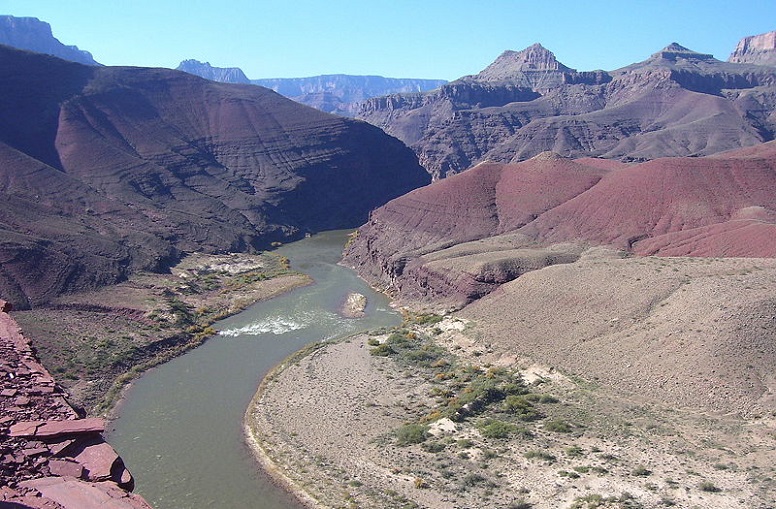Daily Business Report-Jan. 22, 2019
The Colorado River. (Image courtesy of San Diego County Water Authority)
Metropolitan Water District begins
a ‘run on the bank’ — the Colorado River
By Ry Rivard | Voice of San Diego
The Colorado River may not look like it, but it’s one of the world’s largest banks.
The river is not only the source of much of the American West’s economic productivity – San Diego, Phoenix and Denver would hardly exist without it – but its water is now the central commodity in a complex accounting system used by major farmers and entire states.
Now, when talking about the river, water officials across the West use terms like bank, payback and surplus. Often the analogies to finance don’t stop there – they put money behind deals that dictate who gets water and who does not.
This month, the nation’s largest water agency, the Metropolitan Water District, began what amounts to a run on the bank.
The district – which delivers water across Southern California, including to San Diego – started rapidly withdrawing water from the river, which is stored behind Hoover Dam in Lake Mead.
Metropolitan officials are worried that the federal government is about to step in to ration the river, which 40 million people depend on as it flows some 1,300 miles from its headwaters in Wyoming and Colorado to the Sea of Cortez in Mexico.
All this is happening because an ongoing drought along the river has collided with years of overuse by the states, primarily California and Arizona.
In recent years, states realized their problem and began trying to create “surplus” water in Lake Mead and bank it for use in future years. But those bank accounts get frozen if the lake’s elevation is below 1,075 feet at the start of a year. Water agencies would still be entitled to annual flows from the river fed by snow melting in the Rocky Mountains, but that’s like living paycheck to paycheck while working for a fickle boss or nearly bankrupt company.
Metropolitan’s immediate concern is that it will lose the ability to withdraw 600,000 acre feet of banked water from Lake Mead – enough water for roughly 7 million people. The district can only get half of that out this year, meaning it is in danger of losing lots of water.
___________________
Westfield UTC announces plan to charge for parking
If you plan on spending a day shopping at Westfield UTC, prepare to pay a little extra.
Starting Jan. 30, shoppers will be charged for parking as a part of Westfield UTC’s new secured parking plan. According to Westfield UTC’s website, the first two hours are free, but after that shoppers are charged $2 for visits lasting 2-3 hours, $4 for visits lasting 3-4 hours, and $6 for visits lasting 4-5 hours. If you plan to spend more than nine hours shopping, expect to be charged the full-day maximum rate of $15.
Parking validations are available for customers of UTC’s Arclight Cinemas, 24-Hour Fitness, and the UTC Ice Sports Center.
In addition to the new charges, Westfield UTC’s plan also includes additional parking options for customers such as a well-lit and secure five-level parking structure, “park assist technology” to help lead drivers directly to the first available open space, a four-lane, drive-up valet service on La Jolla Village Drive (which costs $8 for four hours and $2 per hour after that), and a designated drop-off and pick-up station for Uber vehicles.
The goal of this new plan is to help alleviate the inconveniences caused by “the hundreds of vehicles left on-site each day by individuals making visits elsewhere in the local neighborhood.”
To learn more information and provide feedback to Westfield UTC, visit westfield.com.
___________________
Women’s March 2019

___________________

Little Italy Food Hall ranks among
the 10 best new food halls in the nation
The Little Italy Food hall is a winner in the 2019 USA Today 10Best Readers’ Choice travel award contest for Best New Food Hall. Voting took place over the course of four weeks through the 10Best Readers’ Choice Award online contest. The Little Italy Food Hall ranks among the top ten new food halls in the nation — and is one of only two California food halls on the list. It is the firs project from San Diego-based hospitality group Grain & Grit Collective. H.G. Fenton Co. is the project’s developer.
“The Little Italy Food Hall was a project of passion and commitment. It is exciting to be recognized among the best projects in the country. We will continue to work hard to serve the Little Italy community and share our passion with our guests,” said Mike DiNorscia, CEO of Grain & Grit Collective.
The Little Italy Food Hall opened July 12, 2018 adjacent to the neighborhood’s new Piazza della Famiglia. Intended as a place of community gathering and familiar faces, it offers six locally-driven food stations, a central bar complete with an Italian-inspired craft cocktail menu and a mobile outdoor chefs’ area featuring pop-up cooking demonstrations from names such as Sam the Cooking Guy. Stations include Ambrogio15, Mein St. Asian Kitchen, Not Not Tacos by San the Cooking Guy, Roast Meat & Sandwich Shop, Single Fin Kitchen and Wicked Maine Lobster. At its center, The Little Italy Food Hall Bar serves local craft beers, wines and craft cocktails made using local spirits.
___________________

Guest Commentary:
Businesses ask if California Air Resources
Board rules are worth the cost
By Allan Zaremberg | California Chamber of Commerce
California produces just 1 percent of atmospheric carbon emissions, yet global leaders and activists care about California regulations. Why is this?
It’s the same reason that California politicos insist on our unique climate regulations. Governors and legislators–here and globally–count on California’s leadership to translate into solutions applicable around the world. If it can work in California, then maybe it can transform global climate policy.
Govs. Jerry Brown and Arnold Schwarzenegger staked their climate policies on the belief that a cost-effective and gradual approach will not upset consumers, destabilize markets or shock voters, but will reduce greenhouse gases released to the atmosphere consistent with projected recommendations for global carbon emission reductions.
This has been the guiding principle of California’s go-it-alone approach. Otherwise, we are simply volunteering our economy and lifestyles for underperformance and discomfort.
The Legislature memorialized this approach in 2017 when it adopted the cap-and-trade system as the state’s central approach to greenhouse gas regulation, rejecting specific command-and-control mandates.
The Legislature directed the California Air Resources Board to “avoid adverse impacts on households, businesses and the state’s economy” and consider the “potential for environmental and economic leakage.”
Right policy, but the Legislature will spend the taxes generated by cap-and-trade on programs that may or may not affect taxpayers’ daily lives.
Rather than allowing regulators to hide the true costs from the public by rolling cap-and-trade taxes into fuel and utility bills, the Legislature should review the goals and impacts of cap-and-trade, and how the increased revenue from motorists and ratepayers will be spent.
For example, the Legislature insisted that cap-and-trade include a price ceiling to prevent shocks to consumers and the loss of economic activity from California to other states.
Setting the price ceiling is tricky because it requires balancing the state’s interests in containing costs for businesses and households with the certainty of reaching targeted greenhouse gas emission levels.
Nonetheless, the Air Resources Board has adopted an aggressive regulation, baking in higher consumer and industry costs in the hope of squeezing out more emission reductions. This approach not only flouts the express will of the Legislature, but undermines the moral authority for engaging in state-level greenhouse gas regulation.
Instead of benchmarking a price ceiling and letting it rise with inflation, the California Air Resources Board has proposed compounding each annual increase by another 5 percent. The effect would be that by 2030, the price ceiling would increase by an additional 60 percent.
The difference in 2018 dollars is a 2030 price ceiling of about $100 per ton of greenhouse emissions, compared to $60 without this adder.
A $40 difference is the equivalent of a 36-cent increase in a gallon of gasoline and double-digit increases in natural gas and electricity rates.
These increases are on top of the costs already assumed under an unadorned cap-and-trade regime, which already anticipates, by 2030, adding more than 50 cents a gallon to gasoline, and hiking utility bills by more than 25 percent.
These will create unavoidable costs to all Californians, especially residents who must commute long distances for work or school, and Californians who live in the interior of the state where temperatures are more extreme. As usual, low-income Californians will pay a larger portion of their income for higher energy prices.
Economic researchers have found that higher compliance costs for industry are directly proportional to higher emission allowance prices. This means that the incentive to move economic activity (and emissions) outside of California will increase along with allowance prices. Limiting allowance prices will limit the flight of jobs and excess emissions.
Cap-and-trade is clearly the superior policy choice to control carbon emissions, costing a third to a half as much as command-and-control policies. But how state officials implement this new pricing regime matters.
It isn’t leadership if nobody follows.
Air regulators and their masters in the legislative and executive branches cannot inspire international replication of these ideas unless they design regulations to contain costs, enhance competition, and minimize pain to ordinary Californians.

Allan Zaremberg is president and chief executive officer of the California Chamber of Commerce, az@calchamber.com. He wrote this commentary for CALmatters.



